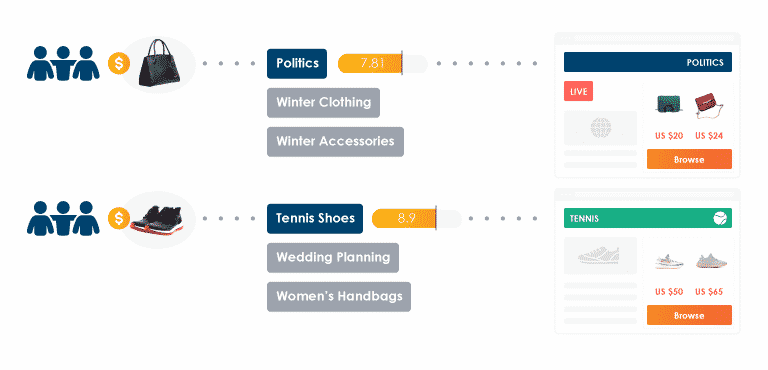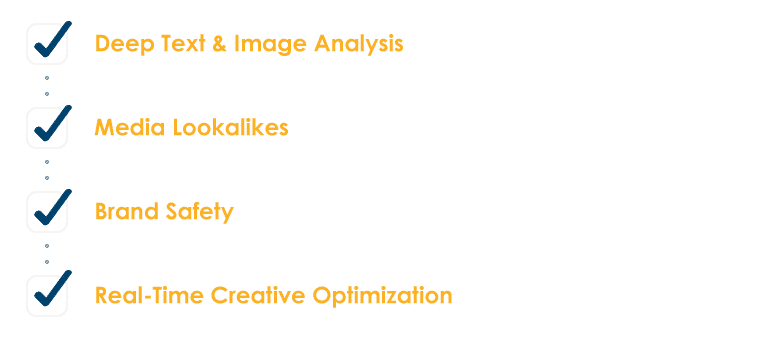First came consumer privacy regulations like GDPR and CCPA. Then came Google’s announcement that third-party cookies would disappear from Chrome in 2022 and Apple’s announcement that iOS 14 users would have to opt-in to the IDFA (the identifier for advertising). This created many new challenges for advertising in the open internet.
Digital advertisers rely on data to personalize and optimize every campaign. After rushing to comply with privacy regulations and maintain their first-party datasets, now advertisers are figuring out what the future of advertising will look like without access to third-party data to enhance their customer profiles.
While third-party cookies are still here, advertisers hope to provide enough value to their customers that they will opt-in to continue to share their personal data. However, that won’t be the case for everyone. For ad campaigns to engage audiences at scale, advertisers and publishers are looking at contextual targeting as the answer to advertising without cookies.
This isn’t the contextual targeting from the early days of digital advertising. In this article, we’re breaking down how contextual advertising provides benefits for advertisers, publishers, and consumers, why it’s more sophisticated than it used to be, and what capabilities to look for in a contextual targeting solution.
Contextual Targeting: Benefits for All
Advertising solutions in a post-cookie world must have an even value exchange between the advertiser, the publisher, and the consumer. Here’s how contextual targeting meets expectations for everyone involved:
Benefits for Consumers
Consumers come first on our list for a reason: All the advertising industry regulations and changes go back to giving consumers the most control and transparency over how their data is used by businesses.
But, in addition to wanting more privacy, consumers also still want some level of ad personalization. The majority (82%) of respondents in the DISQO Ad Relevance Survey say they want to see relevant ads.1
Contextual targeting delivers relevant ads by analyzing the content being consumed—not the specific person who is consuming it—and therefore, it does not rely on third-party cookies at all. Ad personalization is based on contextual signals from a webpage, and it’s becoming more common for advertisers to use commerce signals from their first-party data as well. Consumers do not necessarily have to opt-in to share their data for contextual targeting to reach them.
Benefits for Advertisers
There are numerous benefits that the “new” contextual targeting has for advertisers today. Here, let’s focus on the fact that advertisers need to continue to engage consumers as they browse the open internet, and contextual targeting is one of the best solutions post-cookies.
In Criteo’s survey of 1,000 senior marketing executives from around the world, one-third say they think their campaigns are too dependent on Facebook, Google, and Amazon.2
Advertisers understand the importance of reaching consumers at every touchpoint that can influence their purchase decisions. Contextual targeting allows advertisers to keep reaching consumers across their favorite websites while delivering relevant ads (we explain how below).
Benefits for Publishers
Though there’s a big focus on advertisers, publishers are feeling just as much pressure to find cookie-less advertising solutions and continue monetizing their audiences. By adopting contextual targeting, publishers can still provide effective advertising placements without third-party cookies.
Another benefit of contextual targeting for publishers is that it requires less keyword exclusion. With the right level of sophistication, contextual targeting can go beyond keywords to understand the sentiment of a page and determine its relevancy and safety. This eliminates the need to put entire content categories off limits (things like breaking news).
Contextual targeting also opens the doors for small, niche publishers to gain ad revenue, because they will have content that is contextually relevant for very specific audiences.
The Next Level of Contextual Targeting
To build contextual campaigns that deliver results comparable to today’s cookie-based advertising, the industry is going beyond traditional keyword targeting. The focus is on bringing together first-party data and the contextual signals that help reach consumers who are in a buying mindset. Here’s how contextual targeting is getting an upgrade in 2021:
Deep Text & Image Analysis
Today, natural language processing (NLP) allows for a deep understanding of the context and sentiment of every webpage. Machine learning is helping advertisers move away from keywords and inclusion lists and rely on AI instead to find the most relevant content, opening up opportunities for their campaigns to get more reach.
For example, if you’re looking to align with a lifestyle keyword, but some of the content with that keyword is critical of that lifestyle, you would not want your ads to appear on those webpages. Rather than exclude an entire content category, AI can understand the sentiment of every webpage and infer where your ads should not be placed.
In addition to text analysis, machine learning can scan images, video, and audio and understand their meaning. This adds to the overall understanding of a webpage and gives advertisers other inventory options, like video and connected TV (CTV) and over-the-top video (OTT) ads.
Media Lookalikes
Advertisers are using their first-party data for contextual targeting to better understand the content interests of their customer base and engage audiences through media lookalikes.
Look for a contextual advertising solution that can analyze your first-party data on recent transactions and uncover what webpages and contextual categories preceded those transactions. These are commerce signals.
It should be able to display ads for the right products or services on media lookalikes—pages and categories similar to those where customers were before they bought those items—based on the newly discovered commerce signals as well as real-time contextual signals.
This enables advertisers to reach consumers that are likely to buy without relying on third-party cookies.

The key to success with this approach is to work with a partner that has access to a large set of commerce data showing transactions from across the web.
Brand Safety
With sophisticated technology comes built-in brand safety. When machine learning analyzes every element of a webpage, it ensures that ads only appear next to relevant content and avoids inappropriate content. This opens up even more ad inventory and campaign reach while giving advertisers peace of mind.
Aim to work with a partner that has enough premium publisher relationships to provide additional scale for your campaigns, and also provides the first-party commerce data that enables more sophisticated targeting.
Real-Time Creative Optimization
Creatives for contextual targeting should be optimized in real time to deliver the most contextually relevant product recommendations for every webpage. The products or services in your ads can be based on commerce signals, contextual relevancy, or your most popular products, and you should have the option to filter the items from your catalog that appear in ads based on availability, location, or subcategory.
Contextual Targeting Checklist
Here’s a simple checklist of things to look for as you find a partner for launching your contextual ad campaigns:

- Deep Text & Image Analysis
Make sure machine learning is scanning text, images, and even video and audio to understand the full context of a webpage. - Media Lookalikes
Use your first-party data to build media lookalikes and reach consumers that are likely to buy without third-party cookies. - Brand Safety
Extend the reach of your campaigns by using machine learning to avoid inappropriate content. - Real-Time Creative Optimization
Show the most contextually relevant products or services for every webpage in real time.
Future-Proof Your Advertising Strategy
Contextual targeting is among the handful of advertising solutions that businesses must test this year to be ready for the future of advertising. Download The 2021 Digital Advertising Manual: Rethinking Budgets & Channels for the New Customer Journey to start adjusting your advertising strategy:
Are you an agency marketer? Download the Agency Edition of The 2021 Digital Advertising Manual: New Opportunities to Drive Client Growth for data and advertising strategies that will help you serve your clients in new ways.
1DISQO Ad Relevance Survey, US, May 2020, n=999
2Criteo COVID-19 Impact on Marketing Survey, Global, October 2020, n=1,039

























